Last updated on
Discover the art of organizing kitchen towels to maintain a neat, functional, and aesthetically pleasing cooking space.
Your kitchen towels are probably one of the most used items in your kitchen. From wiping spills and cleaning counters to drying dishes and hands, they are constantly in use.
But with all that usage, it’s easy for them to become disorganized and cluttered. So, if you’re tired of digging through a messy pile of towels every time you need one, it’s time to get organized! In this article, we’ll share some simple yet effective tips on how to organize your kitchen towels so that they’re always within reach when you need them.
Say goodbye to towel chaos and hello to an organized and functional kitchen!
Key takeaways:
- Store towels in drawers or cabinets using folding techniques
- Use drawer dividers for easy towel organization
- Hang towels using adhesive hooks or towel racks
- Use storage baskets or containers to keep towels tidy
- Rotate towel sets to ensure even wear and use
What's Inside
Types of Kitchen Towels
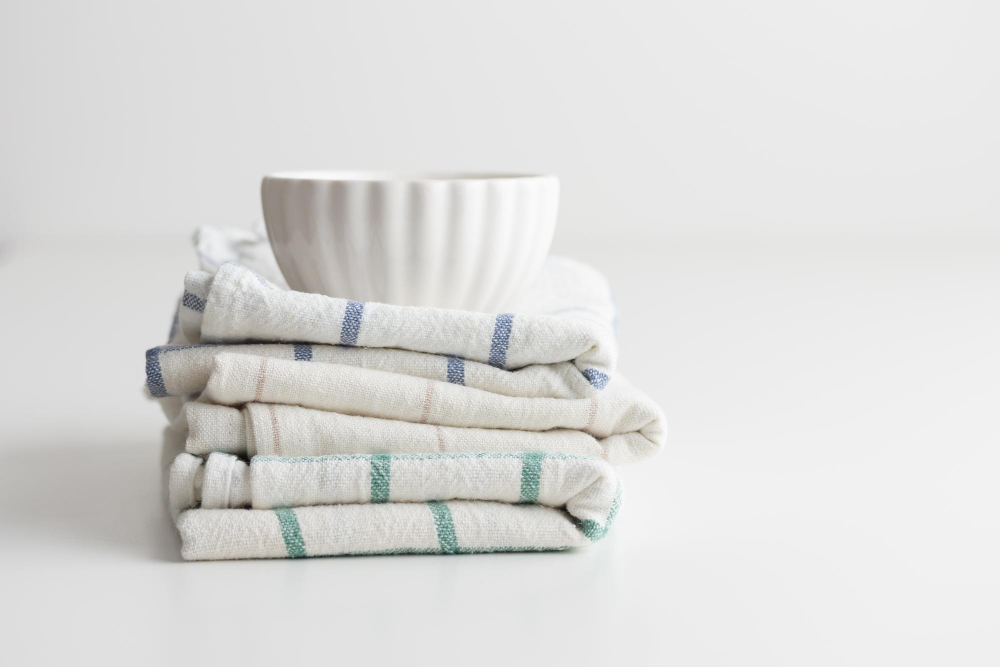
When it comes to kitchen towels, there are several types available on the market. Each type has its unique features and benefits that make them suitable for different tasks in the kitchen.
Some of the most common types of kitchen towels include dish towels, tea towels, flour sack cloths, and microfiber cloths.
Dish Towels: These are typically made from cotton or a cotton blend material and come in various sizes. They’re great for drying dishes or wiping up spills.
Tea Towels: These are similar to dish towels but tend to be smaller in size. They’re often used for decorative purposes such as lining bread baskets or covering baked goods.
Flour Sack Cloths: Made from 100% cotton fabric with a tight weave pattern that makes them highly absorbent; they can be used as an alternative to paper towel rolls since they’re reusable.
Microfiber Cloths: These have become increasingly popular due to their ability to clean surfaces without leaving streaks behind; they’re also very durable and long-lasting compared with other materials like paper towel rolls.
Determining the Right Number of Towels
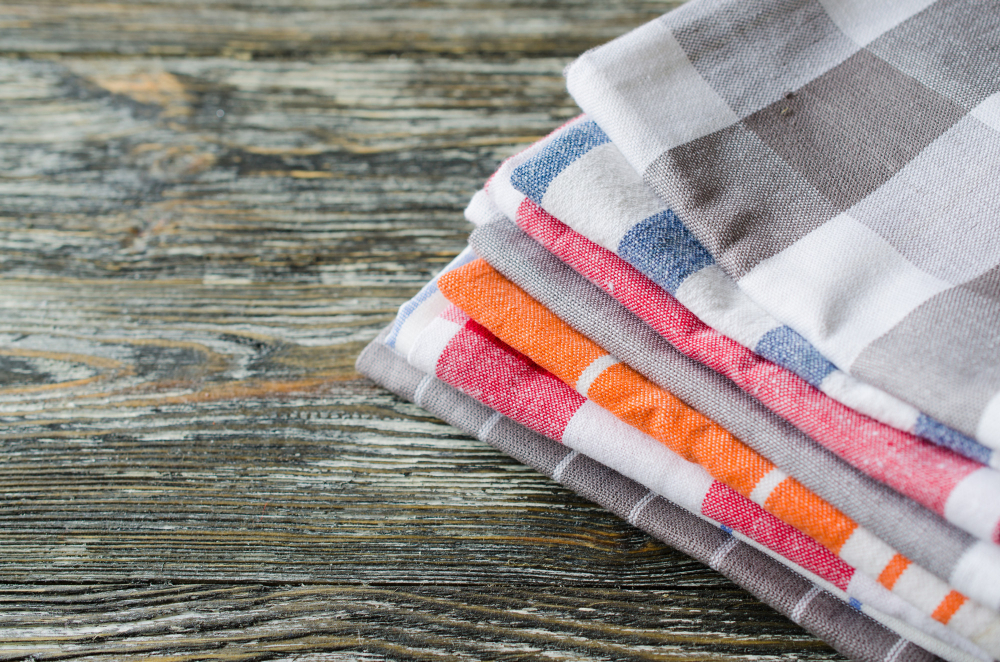
Having too few towels can lead to constantly doing laundry, while having too many can create clutter and take up valuable storage space.
To determine the right number of towels for your household, consider factors such as how often you cook and clean in the kitchen, how frequently you do laundry, and whether or not guests visit regularly. As a general rule of thumb, it’s recommended to have at least three sets of kitchen towels per person in your household.
If you’re unsure about how many is enough for your needs or if there are any special considerations that should be taken into account when determining towel quantity (such as allergies), consult with a professional organizer who specializes in kitchens. They’ll be able to help guide you towards an appropriate number based on your specific situation.
Decluttering Towels
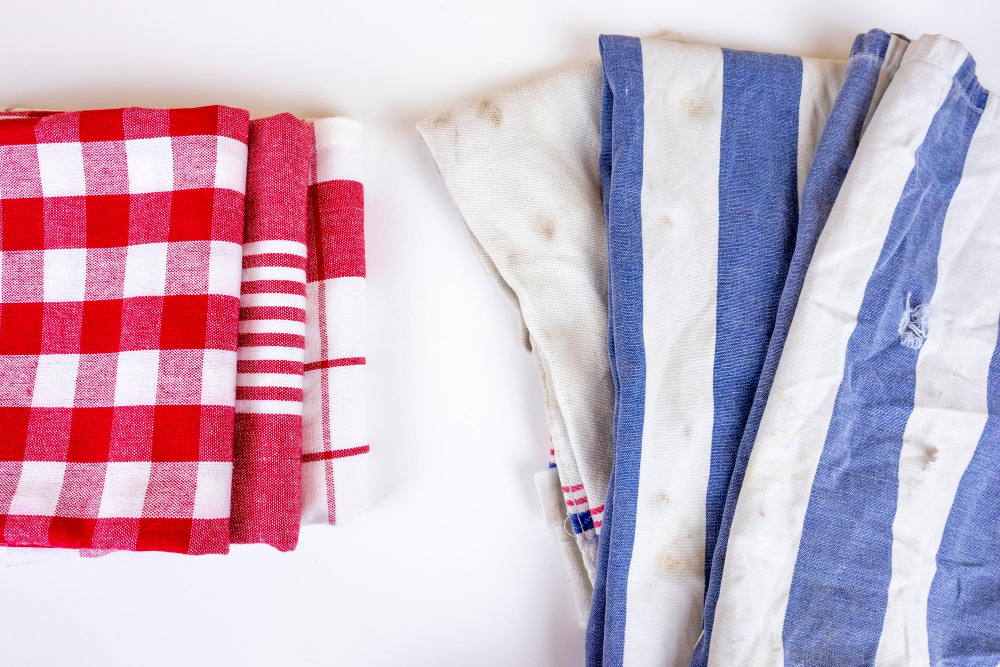
Go through all of your towels and get rid of any that are stained, torn or have holes in them. Also, consider donating any extra towels that you don’t need or use anymore.
Once you’ve narrowed down the number of kitchen towels to keep, sort them by type and size. This will make it easier for you to find what you need when cooking or cleaning up after meals.
Folding Techniques
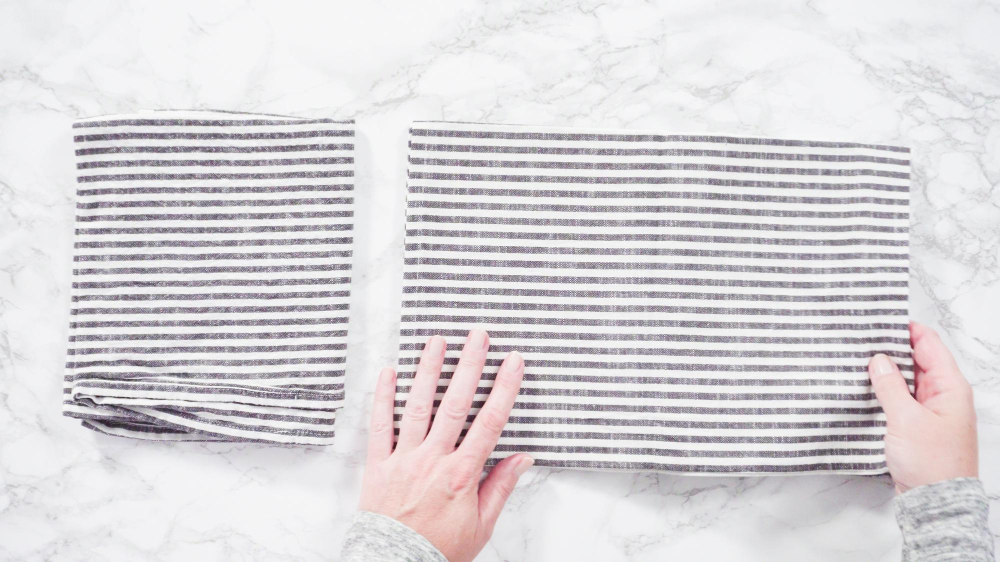
Folding techniques not only help keep the towels organized but also save space in your drawers or cabinets. The most common folding technique is the rectangle fold, where you simply fold the towel in half lengthwise and then again widthwise.
This creates a neat square that can be easily stacked.
Another popular folding technique is called “the roll.” To do this, lay out your towel flat and then roll it tightly from one end to another like a burrito. This method works well for smaller towels or if you have limited drawer space.
If you prefer hanging up your kitchen towels instead of storing them away in drawers or cabinets, try using a clothes hanger with clips attached to hang multiple folded towels vertically on one hanger.
Drawer Organization
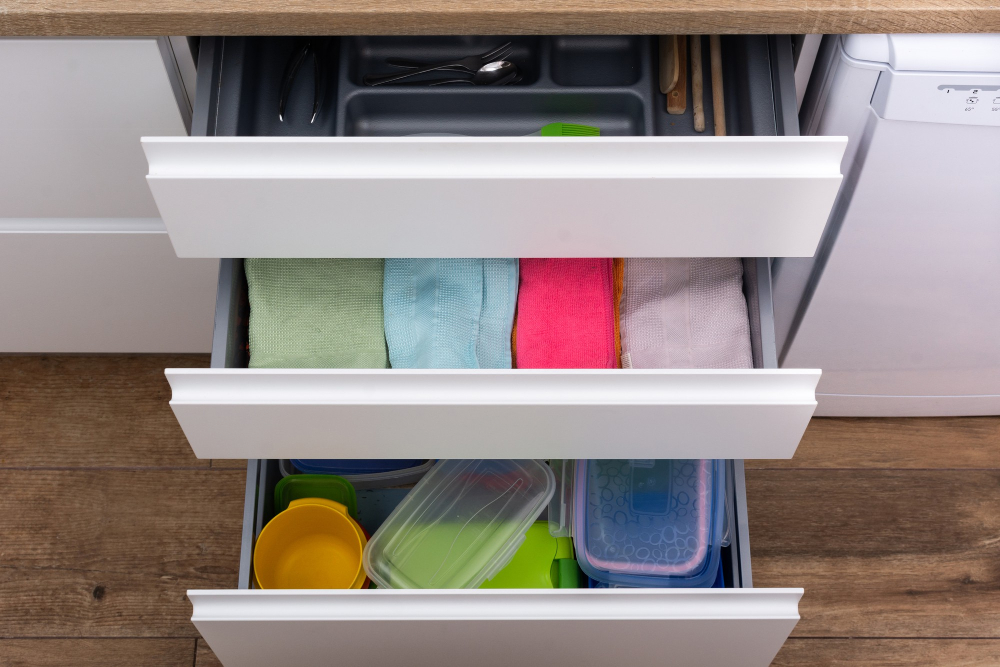
Drawer dividers are an excellent way of keeping your towels separated and easy to find. You can use adjustable dividers or make your own by cutting cardboard boxes into the desired size and shape.
To start organizing, remove all the towels from the drawer and sort them by type or color. Then fold each towel neatly before placing them back in their designated section of the drawer.
Another option is rolling up your kitchen towels instead of folding them; this method saves space while still allowing for easy access when needed.
Remember that organization is not just about functionality but also aesthetics! Consider using decorative liners inside drawers for added style and protection against dirt buildup over time.
Using Drawer Dividers
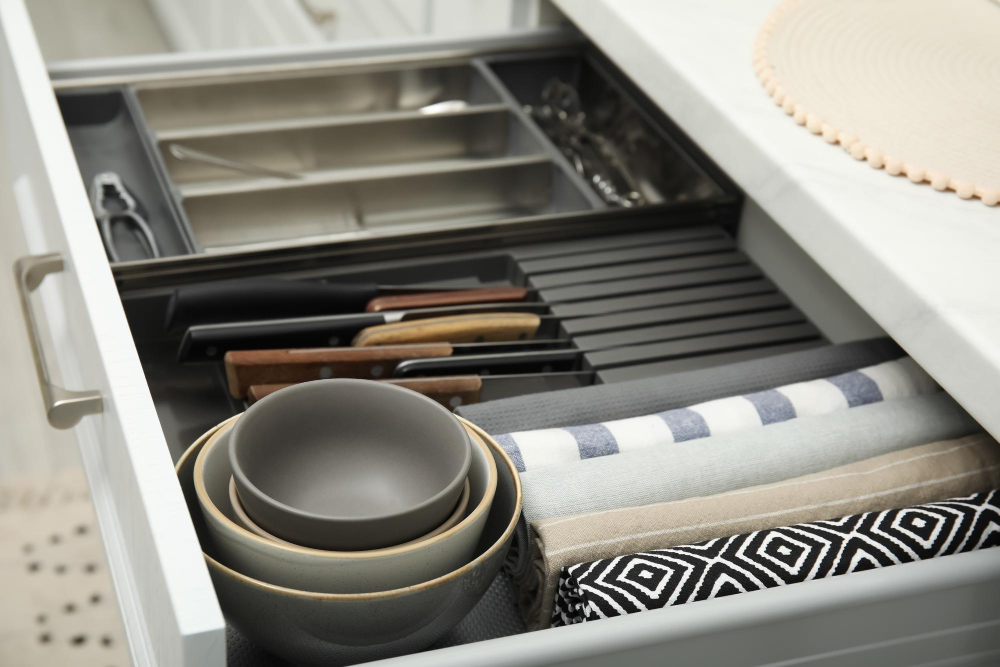
They come in various sizes, shapes, and materials such as plastic or bamboo. You can use them to separate different types of towels or organize by color.
To start organizing with drawer dividers, first remove all the towels from the drawer and clean it out thoroughly. Then measure the width and length of your drawer so that you can purchase a divider that fits perfectly inside.
Once you have purchased a suitable divider for your needs, place it inside the drawer according to its instructions. Next, sort through your kitchen towel collection into categories such as dishcloths or hand towels.
Place each category in its own section within the divided space so that they’re easily accessible when needed. This method not only keeps everything tidy but also helps prevent cross-contamination between different types of kitchen tasks (e.g., wiping counters versus drying dishes).
Hanging Solutions

There are several ways to hang your towels, depending on the layout of your kitchen and personal preference.
One popular method is using adhesive hooks. These hooks can be attached to any smooth surface and come in various sizes and designs.
They’re perfect for hanging dish towels near the sink or oven mitts near the stove.
Another option is installing a towel bar or rack on an empty wall space in your kitchen. This not only provides ample storage for multiple towels but also adds a decorative touch to your cooking area.
For those who prefer something more discreet, consider installing towel rings underneath cabinets or shelves. This keeps them out of sight while still being easily accessible when needed.
No matter which hanging solution you choose, make sure it’s sturdy enough to hold the weight of wet towels without falling off its mountings.
Towel Racks and Hooks

They are easy to install, come in various sizes and styles, and can hold multiple towels at once. You can choose from wall-mounted racks or over-the-door options depending on the layout of your kitchen.
Wall-mounted towel racks are perfect if you have an empty wall space that needs some functional decor. They come in different materials such as wood, metal or plastic so you can match them with your existing kitchen design.
Over-the-door towel hooks are ideal if you don’t want to drill holes into walls but still need extra storage space for your towels. These hooks fit easily over most standard-sized doors without causing any damage.
Storage Baskets
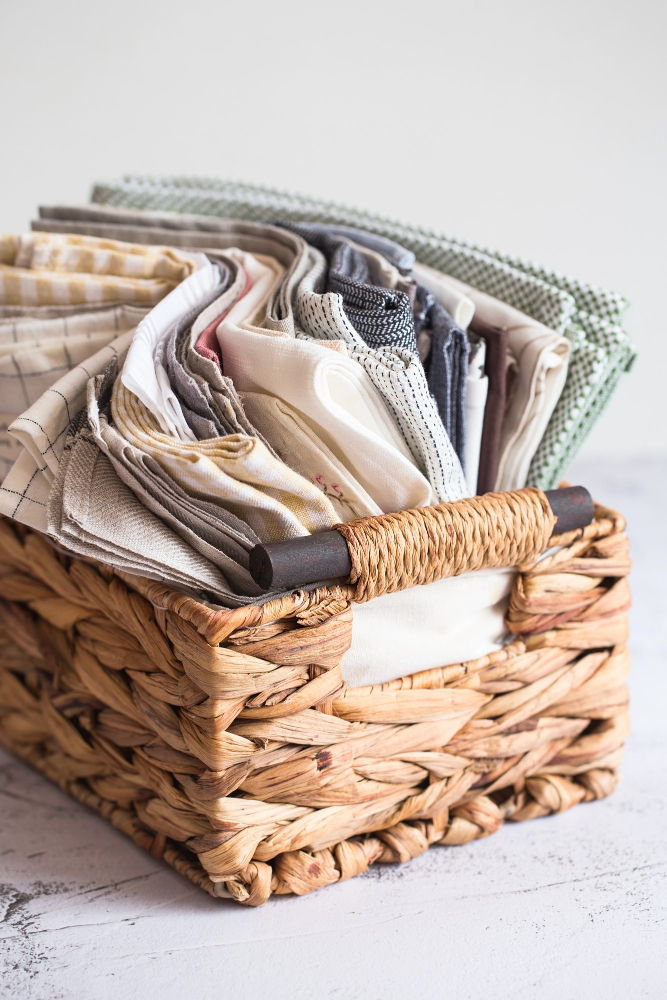
They come in various sizes, shapes, and materials such as wicker, wire mesh or plastic. You can use them to store clean towels or dirty ones that need laundering.
Baskets also add a decorative touch to your kitchen decor while keeping things tidy.
To make the most of storage baskets for organizing your kitchen towels, consider labeling each basket according to its contents so you can quickly find what you need without having to dig through multiple baskets.
You can place these storage containers on shelves or countertops for easy access when cooking up a storm in the kitchen. If you have limited counter space, try hanging them from hooks on the wall instead.
Storing Towels in Baskets or Containers
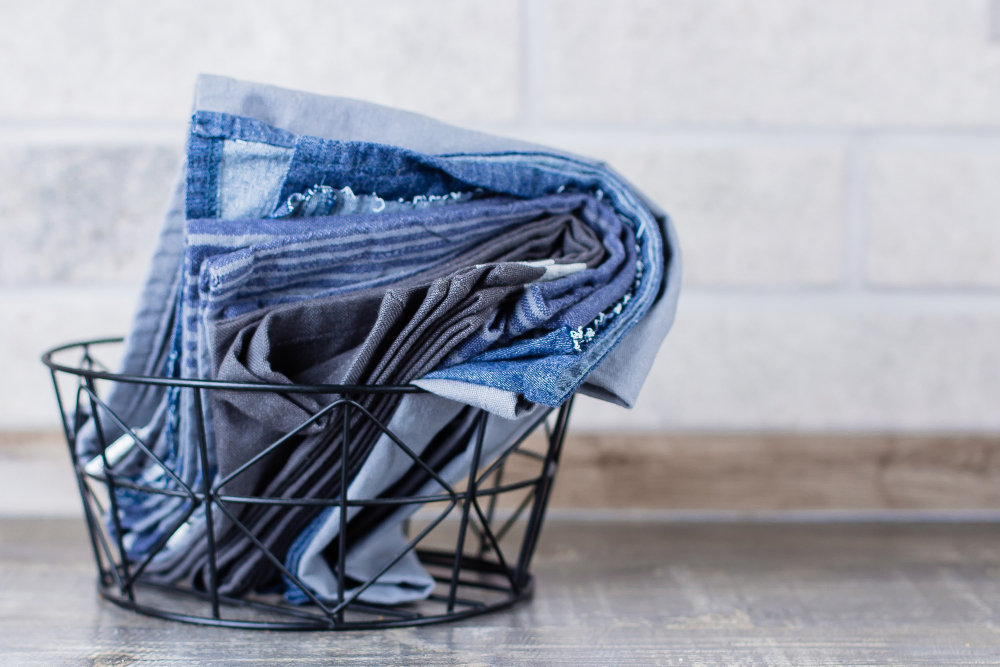
Baskets are perfect for storing folded towels, while containers with lids can be used to store clean, unused towels. When choosing a basket or container, make sure it’s the right size for your needs and fits well in the space you’ve designated for towel storage.
If you have open shelving in your kitchen, consider using decorative baskets that match your decor style. This not only keeps things tidy but also adds an element of design to the room.
For those who prefer closed storage solutions like cabinets or drawers, clear plastic bins with labels can help keep everything organized and easy to find when needed. You could even use different colored bins based on towel type (e.g., dishcloths vs hand-towels) if color coordination is important to you.
Labeling Towels

Labeling your towels is an easy and effective way to avoid confusion and ensure that everyone has their own designated towel. You can use fabric markers, iron-on labels, or even embroidery to label each towel with the name of its owner.
Another option for labeling towels is color-coding them based on their intended use. For example, you could designate red towels for cleaning up spills and blue ones for drying dishes.
This method not only helps with organization but also ensures that each towel stays in its proper place.
Color Coordination
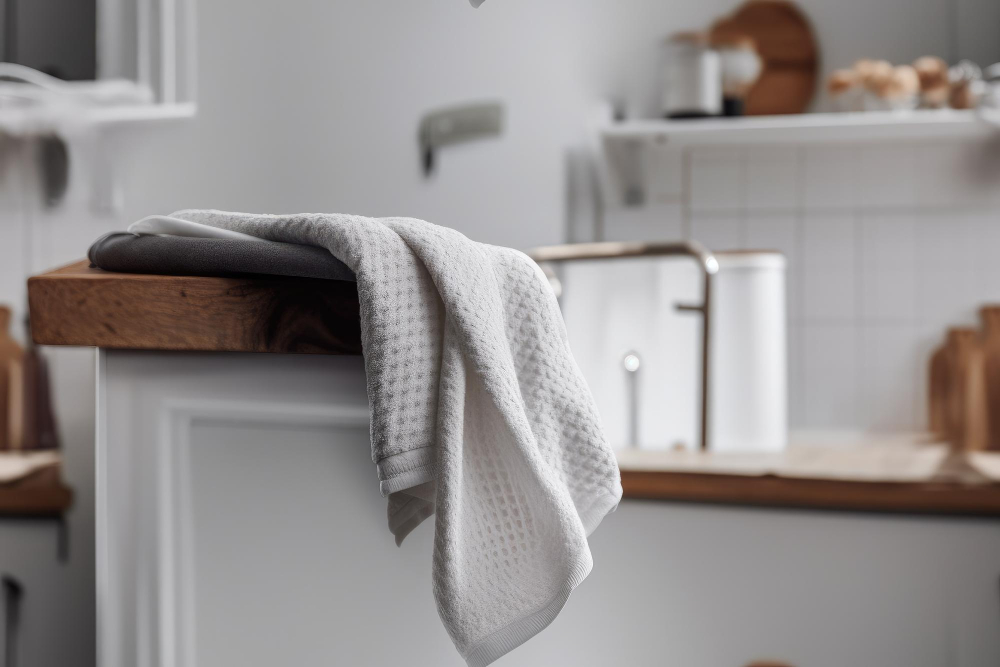
It not only adds a touch of style to your cooking space but also makes it easier to find the towel you need quickly. When choosing colors for your kitchen towels, consider the color scheme in your kitchen and choose hues that complement or contrast with it.
For instance, if you have a neutral-colored kitchen, adding bright colored towels can add some pop and vibrancy to space. On the other hand, if you have a colorful backsplash or countertop surface in shades like blue or green tones, white or beige-colored towels will create balance.
Another way to coordinate colors is by using seasonal themes such as reds and greens during Christmas time while pastel shades are perfect for springtime decor.
Rotating Towel Sets
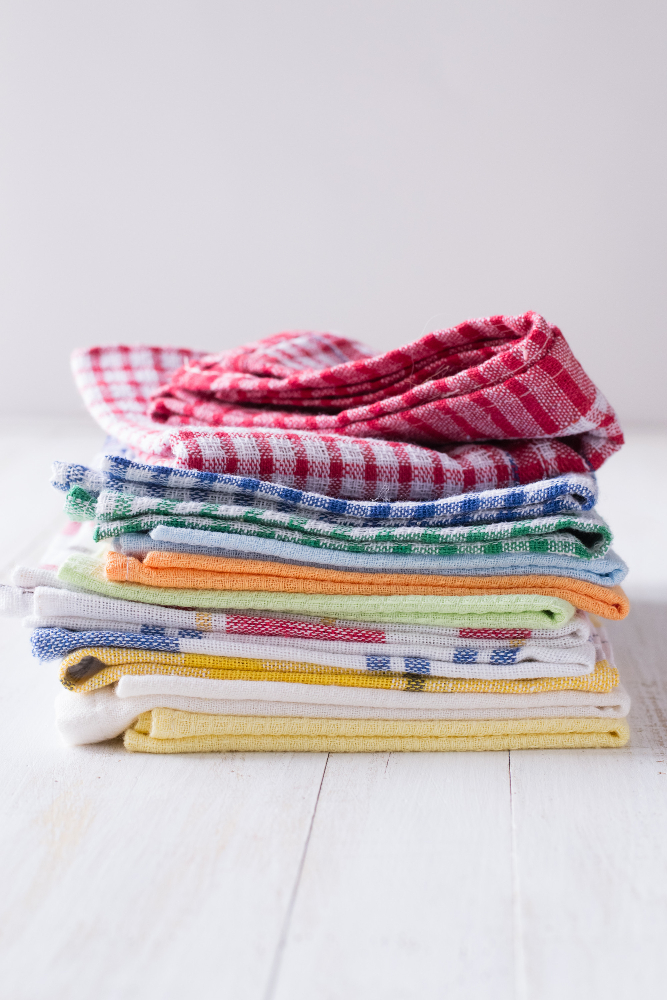
Rotating your towel sets ensures that they wear evenly and last longer. It also gives you the opportunity to use all of your towels instead of just reaching for the same ones over and over again.
To start rotating your towel sets, divide them into two or three groups depending on how many you have. Keep one group in use while storing the others away until it’s time to switch things up.
You can do this every week or every month, depending on how often you use your towels.
When rotating out a set of towels, make sure they are clean before putting them away in storage. This will prevent any musty smells from developing while they’re not being used.
Proper Laundering
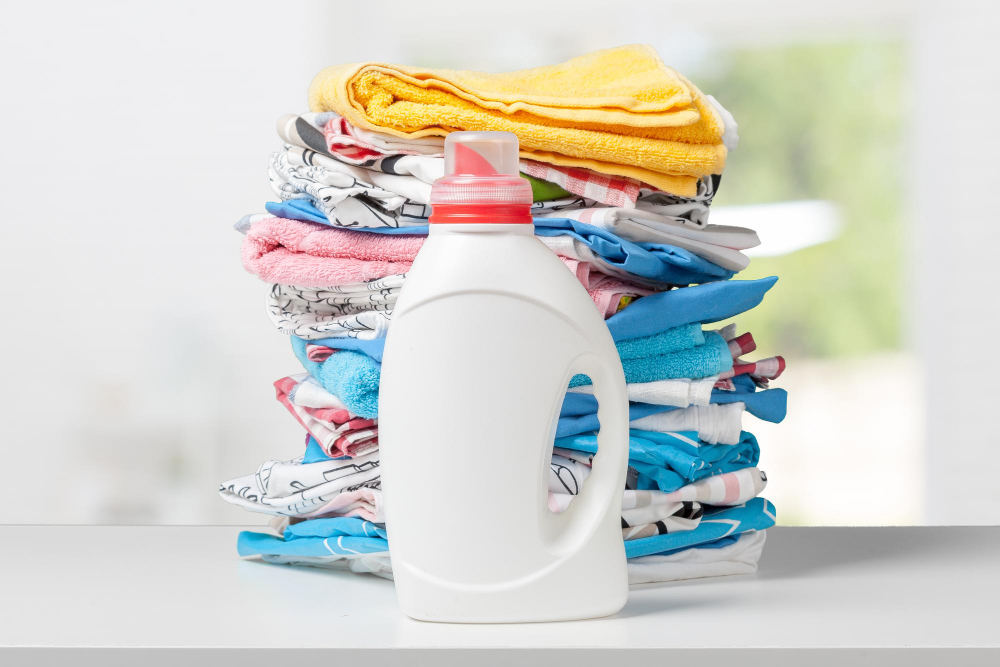
Proper laundering techniques can help extend the life of your towels and keep them looking fresh and new. It’s important to wash kitchen towels frequently, especially if they’re used to wipe up spills or raw meat juices.
When washing your kitchen towels, avoid using fabric softeners as they can reduce absorbency. Instead, use a mild detergent and hot water to kill bacteria effectively.
If you have colored or patterned towels, be sure to separate them from white ones when washing.
To prevent lint buildup on your other laundry items during the wash cycle, it’s best not to mix heavily soiled dishcloths with clothing items that are prone to collecting lint like fleece jackets or wool sweaters.
After washing the towel load in hot water with detergent (and bleach if necessary), dry on high heat until completely dry before folding and storing away in their designated spot.
Upcycling Old Towels

For example, you can cut them into smaller pieces and use them as cleaning rags or dust cloths. You can also sew several pieces together to create a larger rag or even make your own reusable kitchen wipes.
Another great way to upcycle old towels is by using them as padding for hot dishes when serving food. Simply fold the towel in half and place it under the dish before placing it on the table.
Old towels can also be used as pet bedding or even donated to animal shelters where they will be put to good use.
Seasonal Towel Storage
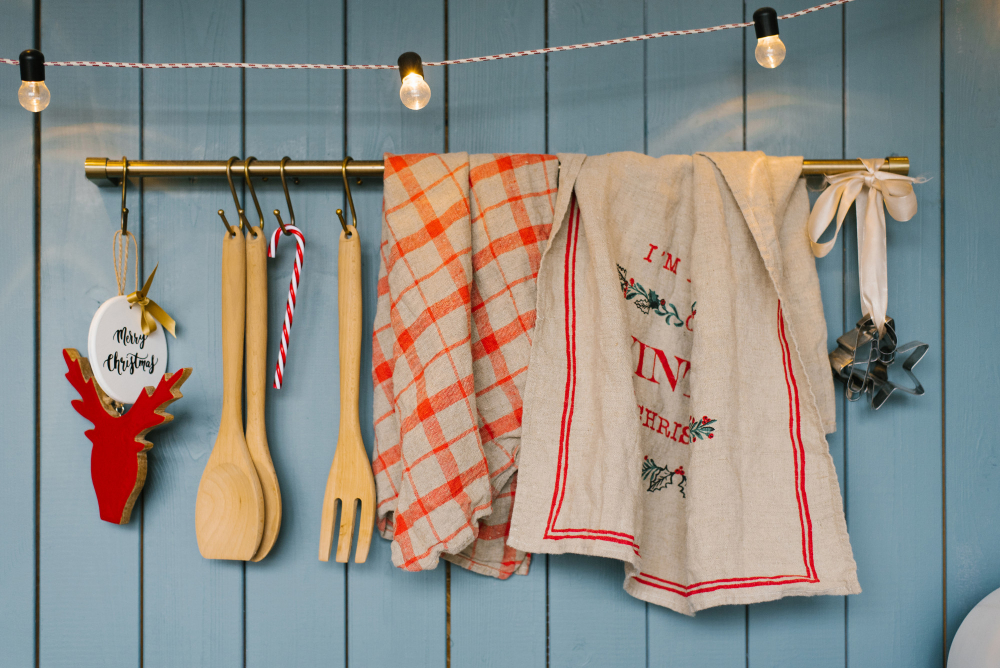
During the holidays, for example, you might want to swap out your everyday towels for festive ones that feature snowflakes or Santa Claus. But what do you do with all those extra towels when they’re not in use? The key is to store them properly so that they stay clean and organized until it’s time to bring them out again.
One option is to use vacuum-sealed bags or space-saving bags designed specifically for storing linens. These will compress your towels down into a smaller size and protect them from dust and moisture while in storage.
Another option is simply folding your seasonal towels neatly and placing them inside labeled bins or baskets on high shelves in your pantry or closet. This way, they are still easily accessible but won’t take up valuable drawer space during off-seasons.
Multipurpose Towel Usage

They can also be used in a variety of ways to make your life easier. For example, you can use them as pot holders or trivets to protect your hands and surfaces from hot pots and pans.
You can also wrap them around frozen foods to absorb excess moisture during thawing.
Another great way to use kitchen towels is as makeshift placemats or napkins when entertaining guests outdoors or at informal gatherings. Simply fold the towel into a neat square, place it on the table setting, and voila! You have an instant placemat that’s both functional and stylish.
Kitchen towels are perfect for cleaning up spills in other areas of the house besides the kitchen – such as bathrooms or laundry rooms – making them truly multipurpose items that every household should have on hand.
Kitchen Towel Safety
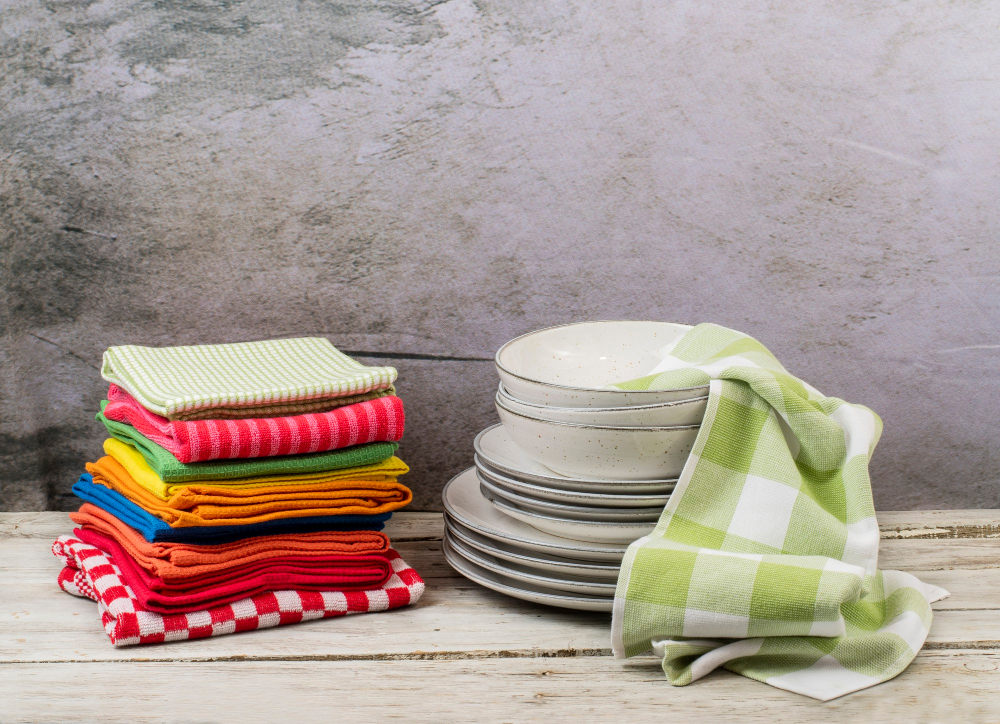
One of the biggest concerns is cross-contamination. If you use the same towel for wiping up raw meat juices and then use it to dry your hands or dishes, you risk spreading harmful bacteria around your kitchen.
To avoid this issue, designate specific towels for different tasks such as one for drying dishes and another for cleaning counters. You can also color-coordinate your towels so that each member of the household knows which towel they should be using.
Another safety concern is fire hazards. Make sure that you don’t leave damp or wet towels near hot surfaces like stovetops or ovens as they can easily catch fire.
Organizing Towels in Cabinets
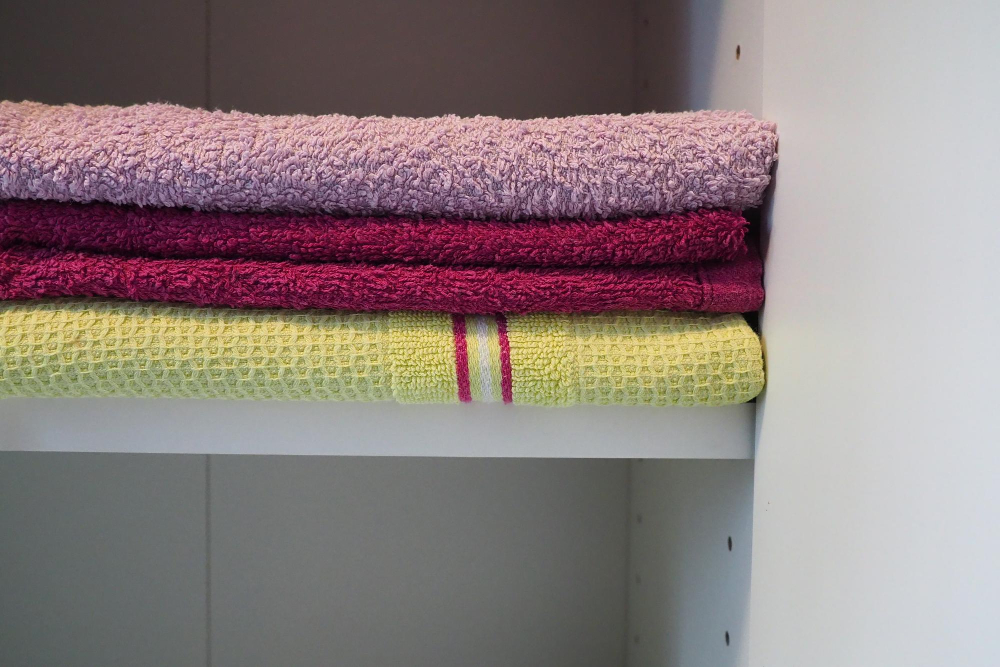
It keeps them out of sight and frees up valuable countertop real estate. However, it’s essential to organize them correctly so that they’re easy to access when needed.
Firstly, determine which cabinet will house your towels and clear out any unnecessary items from the space. Next, consider using shelf risers or dividers to maximize vertical storage space within the cabinet.
When organizing your towels inside the cabinet, fold each towel neatly into thirds or quarters (depending on their size) before stacking them vertically with similar-sized ones together. This method not only saves space but also makes it easier for you to grab a towel without disturbing others around it.
To keep things even more organized and accessible at a glance, consider labeling each stack of folded towels by type (e.g., dishcloths vs hand-towels). You could use adhesive labels directly on the stacks themselves or attach tags with string if preferred.
Store Inside Cabinet Doors
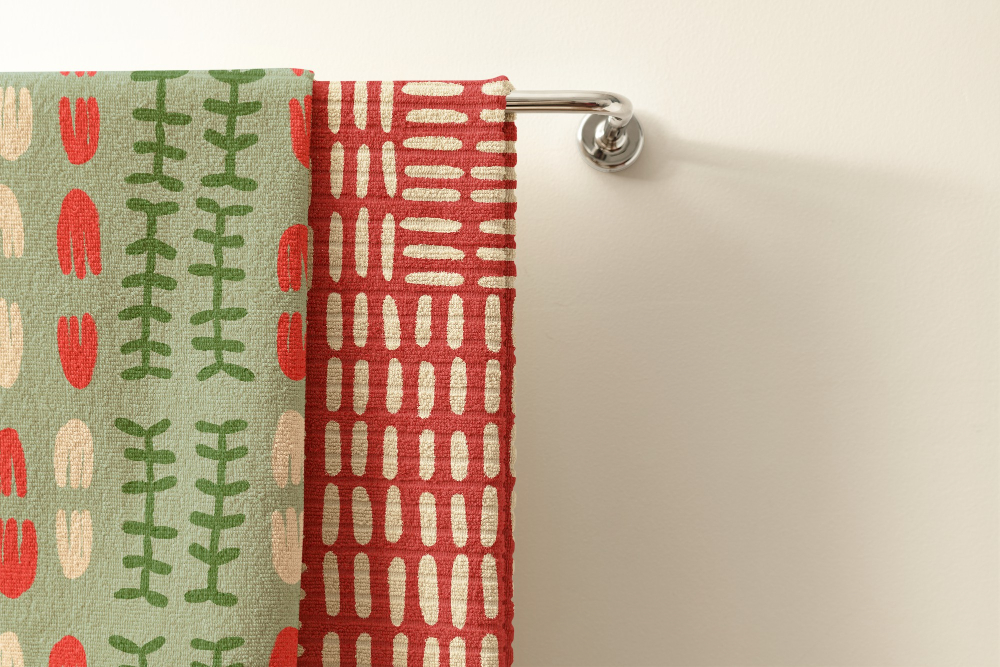
This method works particularly well if you have limited counter or drawer space in your kitchen. To get started, all you need are some adhesive hooks or towel bars that can be easily attached to the inside of your cabinet doors.
First, determine which cabinets would work best for storing your towels. You may want to choose a cabinet near the sink or stove for easy access while cooking and cleaning.
Next, attach the adhesive hooks or towel bars onto the inside of the door at an appropriate height so that they don’t interfere with any items stored on shelves within.
Once installed, simply hang up each towel by folding it in half lengthwise and draping it over one hook/bar so that both ends hang down evenly on either side. Repeat this process until all towels are hung up neatly.
By using this simple storage solution, not only will you free up valuable counter space but also ensure quick access when needed most!
FAQ
What is the best way to organize kitchen towels?
The best way to organize kitchen towels is to fold them in half twice, then in thirds, ensuring they stand up on their own, and store them upright in a drawer, basket, or organizer, side by side.
How does Marie Kondo fold kitchen towels?
Marie Kondo folds kitchen towels by folding them in half twice, then in thirds, ensuring they can stand up on their own in a drawer, basket, or organizer.
Where do you put decorative kitchen towels?
Decorative kitchen towels should be placed on a metal rack under the sink for efficient use of space and easy access.
What are some creative storage solutions for kitchen towels?
One creative storage solution for kitchen towels is using hooks, repurposed magazine racks, or decorative baskets hung on the wall or mounted under the cabinet.
How often should you replace or clean kitchen towels?
Kitchen towels should be replaced or cleaned every day to maintain proper hygiene.
Can repurposing old kitchen towels contribute to an organized kitchen?
Yes, repurposing old kitchen towels can contribute to an organized kitchen by serving as multi-functional tools for cleaning, storage, and other purposes.




